This page is in no way representative of the very robust weaving community all over the country of Vietnam. It simply reflects what we’ve seen in 2 visits to the country.
Sapa
If you have an interest in textiles and you are planning to book a tour to Vietnam but the tour you are considering does not include a trip to Sapa; you need to find a different tour or arrange an independent trip there on your own!
With the beautiful mountains and rivers running through the valleys and rice fields terraced thousands of feet down the side of the mountains, the countryside is spectacular but the thing that makes it so amazing is the people who live up there.
Sapa is a small town near Ham Rong Mountain that is surrounded by even smaller villages populated by numerous ethnic minority tribes. Some are indigenous to the area but most tribes arrived there seeking refuge from war or oppression in other parts of Asia. To a large degree, the people have clung to their traditional lifestyle that doesn’t appear to have changed too much in the past 1000 years. Each tribe wears a different color apparel and along with agriculture, the making and selling of textiles is their main source of income.
Costume is really not the right word to describe the local dress as the people there are not dressed this way to please the tourists. It is an integral part of the lifestyle and a way for members of the ethnic group to identify themselves to members of the same group from different parts of the countryside. It is really amazing to see the different colors, hair styles and profiles of the different tribes all mixed together in the town.
Some visitors to Sapa are put off by the frequent approach of women and girls selling textiles their family has made. But keep in mind that these are dear, sweet people. Even when they are trying to sell you something in the street, they are charming. And it is remarkable how many of them speak English. As you are trekking through the villages, people (almost exclusively women) will follow along for miles and chat. It really is a remarkable experience.
Most people that visit Sapa plan on trekking through some of the nearby villages. Some take 2-3 day treks and include an overnight home stay in one of the villages. We’ve made 2 trips to Sapa and our approach has been to travel by jeep to nearby villages in the morning, walk between and in towns for 3-5 hours and then met the jeep for the ride back into Sapa for the night.
On the weekend, villagers from all over the area walk into Sapa to sell their goods on the central square and to meet with other people from different villages at what is known as the “love market” on Saturday night.
On different days of the week, there are markets in different villages in the area. On the Sunday during our first trip there we visited the remarkably colorful Bac Ha Market located about 2½ hours from Sapa very near the border with China. The drive through the mountains to Bac Ha was both beautiful and a bit harrowing. And as demonstrated by the above photos, the scene there is about as colorful as any place on earth could be.
Muong Khuong Market
Bac Ha has become one of the more popular markets for visitors to the area so on our second trip to Sapa we wanted to go a market that was primarily oriented to the local population. We decided to visit another Sunday market at Muong Khuong.
Muong Khuong is a large market gathering about a 2-hour drive from Sapa in the same general area as Bac Ha described above. It is visited by shoppers and merchants of a wide range of ethnic groups; some of whom come over mountain trails across the nearby border with China to sell their products.
We arrived a little too late to see the livestock section but walking through the textile, produce and the meat sections of the market was a great treat. With the different minority groups represented (Black, Flower & White Hmong, Red & Black Zhou, Dao, Nung, Pa Zi and others) this is an extraordinarily colorful market shown in the video below.
We walked through the market a couple times and made a few small purchases of fabrics, some incense as well as some snacks including whole peeled (very small) pineapples for the equivalent of roughly 10 cents each but mostly just watched the people.
Hanoi
At one time, weaving was a very integral part of life in Hanoi, much like it still is in some other more rural settings. However in today’s world, if you Google “Hanoi Weaving” what comes up most commonly is “Van Phuc, Hanoi’s ancient silk weaving village”
So on our second visit to the city, we hired a guide and we hopped into a cab for the half hour ride out to Van Phuc Silk Village.. While virtually every house you pass in the this picturesque village is devoted to the selling of silk, during the entire afternoon we were there, we didn’t see a single person sitting at a loom weaving. What we did see was a village that is mostly devoted to selling silk by the yard and finished products.
And be warned, not everything you will see and identified as “silk” in Van Phuc is 100% organic. What is known locally as “Chinese Silk” is not a natural product.
We did stop into one mechanical weaving workshop that was one step beyond a hand loom. It looked very much like heavy wooden looms we’ve seen in other places but had been fitted with a 2-stroke engine and a primitive punch card type of programming and was clanking away on its own.
Despite the fact some of what you find in Van Phuc may not be 100% silk, it is one of the better places in Hanoi to get the greatest selection and prices on “silk” products.
If you are not able to include a trip to Sapa or some other similar place on your trip to Hanoi, you can find some very nice examples of that style of textiles in small shops in the Old Quarter; albeit at a much higher price than at the origin.
Even if you are able to venture outside of the city in search of weavers, a visit to the Vietnam Museum of Ethnology before you travel offers an excellent introduction to the customs and crafts of the 54 ethnic groups officially recognized in Vietnam.
Cham Weavers on the Mekong River
Our first experience with weavers in Vietnam was actually in the south of the country near the Mekong River border with Cambodia.
That trip began in Vietnam with a few days in Ho Chi Minh City (Saigon). We decided that rather than do a day trip to the Mekong Delta out of Saigon, we would travel by river to Phnom Phen, the capital of Cambodia via the Mekong River. On the first day our trip ended up being a little more bus and a little less river than we expected but it was still worthwhile. We overnighted in the river border town of Chau Doc.
The next morning we were taken by rowboat through a floating village and floating fish farms to a village of Cham people, a minority group that practices Hindu in some parts of Vietnam but is primarily Muslim in Cambodia. The small Cham village that we visited (so close to the border with Cambodia) is Muslim.
After spending some time hanging out with several weavers in a local workshop, we were rowed out to the middle of the river and boarded a water taxi for about a 3-hour ride into Cambodia.



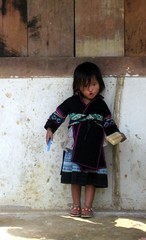



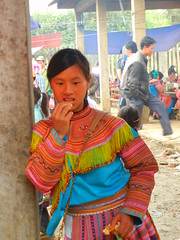

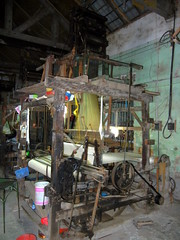
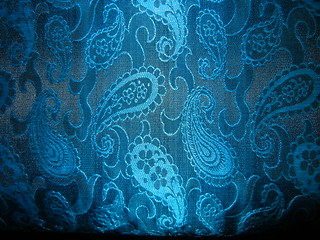
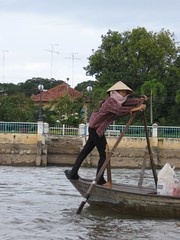


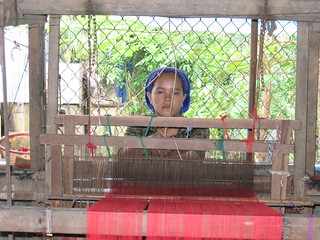
Leave a Reply